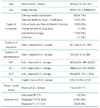Abstract
Medicinal herb-induced liver injury reported on the literature ranges from mild elevation of liver enzymes to fulminant liver failure and liver cirrhosis. Medicinal herbs are common ingredients of traditional Chinese herbs. The mechanisms of medicinal herb-induced liver injury are mainly intrinsic hepatotoxicity. In addition to the potential for hepatotoxicity, medicinal herbs frequently induce herb-drug interaction and herb-herb interaction and may affect its own efficacy and safety. Sometimes hepatotoxicity of medicinal herbs originates from the substances of illegal adulterations and contaminations rather than its own indigenous components. Moreover, individual susceptibility to toxic liver injury should be considered in every instance. Two big problems exist in the management of medicinal herbs-induced liver injury. Because the release of prescriptions is not obligatory in Korea, it is impossible to identify ingredients in case of medicinal herbs-induced liver injury. Misconception on the safety of medicinal herbs prevails throughout the country.
Figures and Tables
References
1. Kessler RC, Davis RB, Foster DF, Van Rompay MI, Walters EE, Eisenberg DM, et al. Long-term trends in the use of complementary and alternative medical therapies in the United States. Ann Intern Med. 2001. 135:262–268.

2. Kraft K, Loew D, Schneider B, Kemper FH. Planning, realization and evaluation of post-marketing surveillance studies. Recommendations of the Society for Phytotherapy. Arzneimittelforschung. 1997. 47:990–994.
3. Castot A, Djezzar S, Deleau N, Guillot B, Efthymiou ML. Pharmacovigilance off the beaten track: herbal surveillance or pharmacovigilance of medicinal plants. Therapie. 1997. 52:97–103.
4. Barnes J. Pharmacovigilance of herbal medicines: a UK perspective. Drug Saf. 2003. 26:829–851.
5. Lavy T, Haran B, Shemer J, Shani S. Regulation of natural medicines in Israel and abroad. Harefuah. 2000. 139:339–344.
6. Briggs DR. The regulation of herbal medicines in Australian. Toxicology. 2002. 181-2:565–570.
7. Rousseaus CG, Schachter H. Regulation issues concerning the safety, efficacy and quality of herbal remedies. Birth Defects Res B Dev Reprod Toxicol. 2003. 68:505–510.
8. Hartigan-Go K. Developing a pharmacovigilance system in the philippines, a country of diverse culture and strong traditional medicine background. Toxicology. 2002. 181-2:103–107.

10. Benninger J, Schneider HT, Schuppan D, Kirchner T, Hahn EG. Acute hepatitis induced by greater celandine(Chelidonium majus). Gastroenterology. 1999. 117:1234–1237.

11. De Berardinis V, Moulis C, Maurice M, Beaune P, Pessayre D, Loeper J, et al. Human microsomal epoxide hydrolase is the target of germander-induced autoantibodies on the surface of human hepatocytes. Mol Pharmacol. 2000. 58:542–551.

12. Ben Yahia M, Mavier P, Metreau JM, Zafrani ES, Fabre M, Mallat A, et al. Chronic active hepatitis and cirrhosis induced by wild germander. 3 cases. Gastroenterol Clin Biol. 1993. 17:959–962.
13. Ahn BM. Herbal preparation-induced liver injury. Korean J Gastroenterol. 2004. 44:113–125.
14. Ahn BM, Lee YJ, Lee KM, Lee DS, Yang JM, Park DH, et al. Prevalence of herbal preparation-induced acute liver injury in hospitalized adults in Korea. Korean J Hepatol. 2001. 7:67.
15. Kim DJ, Ahn BM, Choi SK, Suh JI, Park SH, Oh SM, et al. Preliminary multi-center studies on toxic liver injury. Korean J Hepatol. 2004. 10:80–86.
16. Castot A, Larrey D. Hepatitis observed during a treatment with a drug or tea containing Wild Germander. Evaluation of 26 cases reported to the Regional Centers of Pharmcovigilance. Gastroenterol Clin Biol. 1992. 16:916–922.
17. Favreau JT, Ryu ML, Braunstein G, Orshansky G, Park SS, Fong TL, et al. Severe hepatotoxicity associated with the dietary supplement LipoKinetix. Ann Intern Med. 2002. 136:590–595.

18. Nadir A, Agrawal S, King PD, Marshall JB. Acute hepatitis associated with the use of a Chinese product, Ma-huang. Am J Gastroenterol. 1996. 91:1436–1438.
19. Stickel F, Baumuller HM, Seitz K, Vasilakis D, Seitz G, Schuppan D, et al. Hepatitis induced by kava(Piper methyscum rhizoma). J Hepatol. 2003. 39:62–67.
20. Sheikh NM, Philen RM, Love LA. Chaparral-associated hepatotoxicity. Arch Intern Med. 1997. 157:913–919.

21. Perron AD, Patterson JA, Yanofsky NN. Kombucha "mushroom" hepatotoxicity. Ann Emerg Med. 1995. 26:660–661.

22. Lee DS, Baek JT, Kim JS, Jeung SJ, Lee HK, Yang KH, et al. A case of toxic hepatitis caused by the Chinese diet food. Korean J Med. 2003. 65:689–692.
23. Eisenberg DM, Davis RB, Ettner SL, Appel S, Wilkey S, Kessler RC, et al. Trends in alternative medicine use in the United States, 1990~1997: results of a follow-up national survey. JAMA. 2000. 280:1569–1575.

24. Watkins RE, Maglich JM, Moore LB, Wisely GB, Noble SM, Redinbo MR, et al. 2.1 A crystal structure of human PXR in complex with the St. John's wort compound hyperforin. Biochemistry. 2003. 18:1430–1438.
25. Zhou S, Lim LY, Chowbay B. Herbal modulation of P-glycoprotein. Drug Metab Rev. 2004. 36:57–104.

26. Lehmann JM, McKee DD, Watson MA, Willson TM, Moore JT, Kliewer SA. The human orphan nuclear receptor PXR is activated by compounds that regulate CYP3A4 gene expression and cause drug interactions. J Clin Invest. 1998. 102:1016–1023.

27. Barone GW, Gurley BJ, Ketel BL, Abul-Ezz SR. Herbal supplements: a potential for drug interactions in transplants. Transplantation. 2001. 71:239–241.

28. Miller LG. Herbal medicinals. Selected clinical considerations focusing on known or potential drug-herb interactions. Arch Intern Med. 1998. 158:2200–2211.
29. Khojasteh-Bakht SC, Chen W, Konigs LL, Peter RM, Nelson SD. Metabolism of (R)-(+)-pulegone and (R)-(+)-menthofuran by human liver cytochrome P-450s: evidence for formation of a furan epoxide. Drug Metab Dispos. 1999. 27:574–580.
30. Wang EJ, Casciano CN, Clement RP, Johnson WW. Inhibition of P-glycoprotein transport function by grapefruit juice psoralen. Pharm Res. 2001. 18:432–438.
31. Wong WM, Wu PC, Yuen MF, Cheng CC, Yew WW, Lai CL, et al. Chronic hepatitis B carriers have more frequent and more severe liver injury with anti-tuberculosis drugs. Gastroenterology. 1988. 114:1366A.





 PDF
PDF ePub
ePub Citation
Citation Print
Print






 XML Download
XML Download